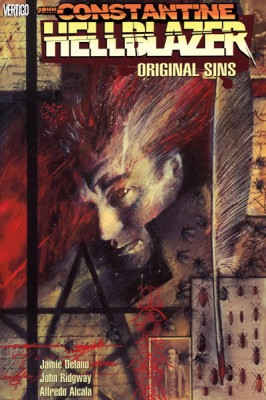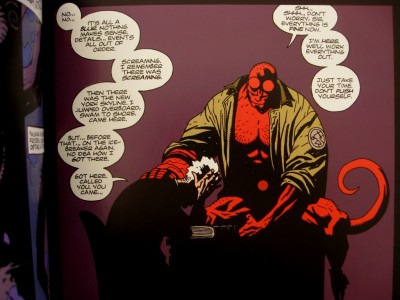Reviewer: Emera
Date read: 4.21.2018 (reread)
Book from: Personal collection (you can read an excerpt online at Tor.com)
The word for this Lovecraftian novella is not exactly luscious, but somehow that’s always what comes to mind when I think about it. Kiernan just does something exceptional with style and tone here: the prose is implacably menacing, cuttingly witty, and both those tones run together with a free-floating, sinuous, sometimes psychedelically inflected quality that is what I want to call luscious. This is also the work that made me realize that while I tend to think of Kiernan as a Gothic writer, she’s also tremendous at noir.
Here’s the scene: It’s Thursday evening, and the Signalman sits smoking and nursing a flat Diet Dr Pepper, allowing himself to breathe a stingy sigh of relief as twilight finally, mercifully comes crashing down on the desert. The heavens above West Second Street are blazing like it’s 1945 all over again and the Manhattan Project has mistakenly triggered the Trinity blast one state over from the White Sands Proving Ground. Or, he thinks, like this is the moment fifty thousand years ago when a huge nickel-iron meteorite vaporized herds of mastodons, horses, and giant ground sloths just sixteen miles southwest of this shitty little diner and its cracked Naugahyde seats and flyblown windows. Either simile works just fine by the Signalman; either way, the sky’s falling. Either way is entirely apropos. He checks his wristwatch again, sees that it’s been only seven minutes since the last time, then goes back to staring out the plate glass as shadows and fire vie for control of the dingy, sunbaked soul of Winslow, Arizona. His unkind face stares at him from the glass, easily ten years older than the date on his birth certificate. He curses, stubs out his cigarette, and lights another.
That’s the first paragraph; it makes me want to read the whole thing all over again. The sense of place throughout Agents of Dreamland is extraordinary: a smoked-out, hard-baked, rusty-blood-stained West, even featuring the Salton Sea, which I’ve been fascinated by for a while. (Inland seas = automatically uncanny?) There’s also a lot of Lovecraftian and UFO-theory allusion that I think pulls together into a compellingly sticky web (this universe of UFO-intercepting spooks feels real, and worn), even if one happens to be foggy on the particular referents. Namely, I had no idea that Dreamland and Paradise Ranch were nicknames for Area 51, and I had forgotten that Lovecraft’s Mi-Go were fungoid in nature – a feature that makes logical the nature of the extraterrestrial pathogen with which the Signalman comes face-to-face.
Darkly lovely also are the jangly, free-associating chapters from the point of view of the wonderfully/sadly named Chloe Stringfellow, a heroin addict turned Lovecraftian cult victim. (If some of her cult leader’s apocalyptic babble sounds a bit silly, callow, I think that that makes sense, in the same way that, say, Beat Poets sound silly once one starts to feel external to the experience of disillusioned adolescence.) I especially appreciated Kiernan’s evocation of Chloe’s longing for belonging – simultaneously diffuse and fire-hot – because right after my first read of Agents of Dreamland, I read John Darnielle‘s Universal Harvester (one of my top three reads of 2017), in which a ragtag Western cult also ends up playing a major role – but we never get to see it from the inside. I always find it strangely moving when accidental echoes run between books I’m reading.
Oddly, even though the future that Agents of Dreamland looks forward to is Grim with a capital G, the novella leaves me in a dreamy, appreciative mood, and one that approaches humorous. There’s a sense that our fates are ruled by a cosmic wink-and-shrug, that we’ve come near to disaster a hundred-hundred times, but chance (or human nature, in Chloe’s case) conspires to deflect us away at the last moment. The Signalman sets the tone here: he tempers fear and resignation with a very hard-bitten humanism, and with a sardonicism that feels beautifully human in direct proportion to the magnitude of horror that he faces.
Related reading:
“Houses Under the Sea,” by Caitlín R. Kiernan (2003)
Alabaster, by Caitlín R. Kiernan (2006)
The Red Tree, by Caitlín R. Kiernan (2009)
The Drowning Girl, by Caitlín R. Kiernan (2012)
If you’ve enjoyed our posts, consider contributing a dollar or two to help support our blog.

